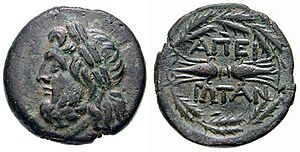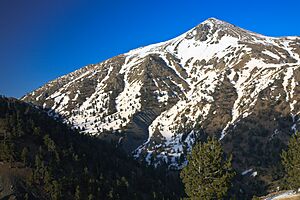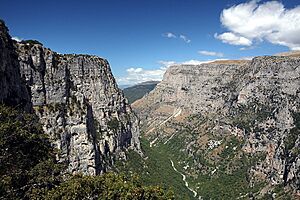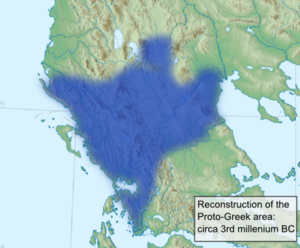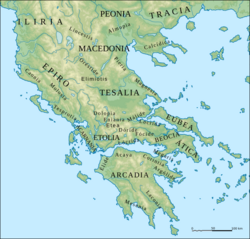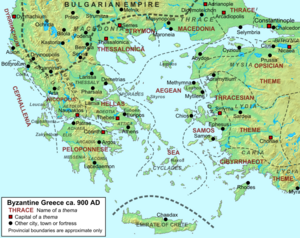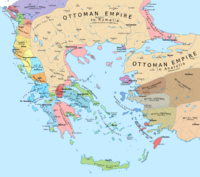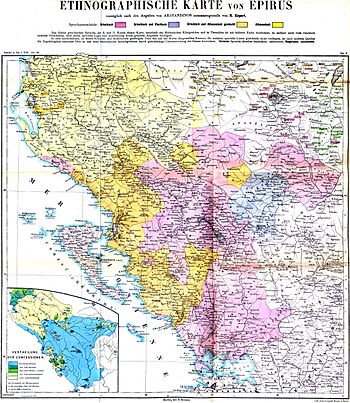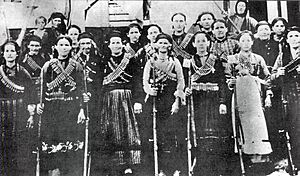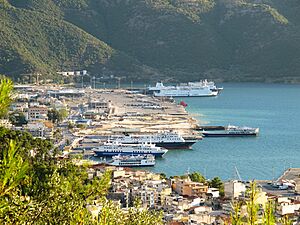Epirus facts for kids
Quick facts for kids
Epirus
|
|
|---|---|
|
Historical region
|
|
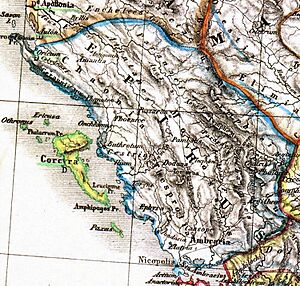
Map of ancient Epirus by Heinrich Kiepert, 1902
|
|
| Present status | Divided between Greece and Albania |
| Demonym(s) | Epirote |
| Time zones | Central European Time |
| Eastern European Time | |
Epirus is a historical region in southeastern Europe. Today, it is split between Greece and Albania. It lies between the Pindus Mountains and the Ionian Sea.
In ancient times, Epirus was the northwestern part of ancient Greece. Greek tribes like the Chaonians, Molossians, and Thesprotians lived there. It was home to Dodona, the oldest oracle (a place where people sought advice from gods) in ancient Greece.
Epirus became a single state in 370 BC. It became famous under Pyrrhus of Epirus, a king who fought against the Roman Republic. Later, Epirus became part of the Roman and then the Byzantine Empire.
After the Fourth Crusade in 1204, Epirus became the center of the Despotate of Epirus. This was one of the states that formed after the Byzantine Empire weakened. In the 15th century, the Ottoman Empire conquered Epirus.
In the early 1800s, Ali Pasha of Ioannina ruled Epirus almost independently. After the Balkan Wars and World War I, southern Epirus became part of Greece. Northern Epirus became part of Albania.
Contents
What's in a Name? The Meaning of Epirus
The name Epirus comes from an ancient Greek word, Ἤπειρος (Ēpeiros). This word means "mainland" or "dry land." It was used to describe the land of northwest Greece, which was opposite the islands of Corfu and the Ionian islands.
The people of Epirus even put this name on their coins. The Albanian name for the region, Epiri, also comes from the Greek word. The same is true for the Aromanian name, Epiru.
Where is Epirus? Its Borders and Lands

Historically, Epirus stretched from the Ceraunian Mountains in the north to the Ambracian Gulf in the south. The Pindus Mountains form its eastern border. These mountains separate Epirus from Macedonia and Thessaly. To the west, Epirus faces the Ionian Sea.
Today, the borders of Epirus are different. The region of Epirus in Greece is only a part of the ancient area. In Albania, the counties of Gjirokastër and Vlorë cover parts of historical Epirus.
Mountains, Rivers, and Wildlife of Epirus
Epirus is mostly a very rugged and mountainous region. It is made up of the Pindus Mountains, which are like the backbone of mainland Greece. These mountains are very steep. The valleys between them are mostly used for grazing animals, not for farming.
The highest point in Epirus is Mount Smolikas, which is 2,637 meters (8,652 feet) tall. Because of winds from the Ionian Sea, Epirus gets a lot of rain. It is one of the rainiest places in mainland Greece.
There are only a few flat areas, mostly near the coast. The Zagori area is a beautiful high plateau surrounded by mountains.
The main river is the Vjosë. It flows from the Pindus Mountains in Greece into Albania. Other important rivers include the Acheron river, known in ancient myths, and the Arachthos river, famous for the historic Bridge of Arta. The Vikos Gorge, one of the deepest in the world, is a major natural wonder. The only large lake is Lake Pamvotis, where the city of Ioannina is located.
Epirus has a Mediterranean climate near the coast and an Alpine climate in the mountains. It has many forests, especially with pine trees. The region is rich in wildlife, including bears, wolves, foxes, deer, and lynxes.
A Look Back: The History of Epirus
Early Times in Epirus
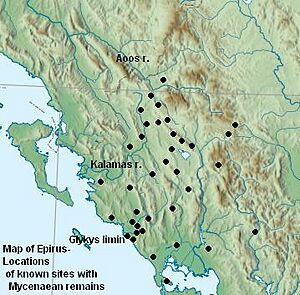
During the Stone Age (Neolithic period), people who traveled by sea lived along the coast of Epirus. Shepherds and hunters from the Balkans also settled there, bringing the Greek language with them. These people buried their leaders in large mounds.
Later, the Mycenaean civilization used similar burial styles. This suggests that the founders of Mycenae might have come from Epirus. Epirus was not as developed as other parts of Greece then. However, important Mycenaean sites were found at the Oracle of the Dead on the Acheron River and the Oracle of Zeus at Dodona.
By 1000 BC, all the tribes in Epirus spoke a West Greek dialect. These included the Chaonians, Molossians, and Thesprotians. The philosopher Aristotle believed that the area around Dodona was part of Hellas and where the Hellenes (Greeks) first came from.
Epirus in Ancient Greece and Roman Times
Epirus was on the edge of the Greek world. Its people lived in small villages, unlike the city-states of southern Greece. It was a frontier area, often fighting with the Illyrian peoples to the north.
However, Epirus was very important for religion because of the oracle at Dodona. This oracle was considered second only to the famous oracle at Delphi.
Some ancient writers called the Epirotes "barbarians". But other writers, like Herodotus, described them as Greeks. They spoke a Greek dialect and had mostly Greek names.
Around 370 BC, the Molossian Aeacidae family started to build a strong state in Epirus. They allied with the powerful kingdom of Macedon. In 359 BC, Princess Olympias of Molossia married King Philip II of Macedon. She became the mother of Alexander the Great.
Alexander of Epirus became king in 334 BC. He invaded Italy but was killed in battle. His nephew, Pyrrhus, became king in 295 BC. For six years, he fought against the Romans and Carthaginians. His victories were very costly, leading to the term "Pyrrhic victory". Pyrrhus brought wealth to Epirus, building the great theater of Dodona and making Ambracia (modern Arta) his capital.
The Aeacid family rule ended in 232 BC. Epirus then became a federal state called the Epirote League. However, the powerful Roman Republic was expanding. Epirus tried to stay neutral in the wars between Rome and Macedon. But during the Third Macedonian War (171–168 BC), the Molossians sided with Macedon, while other tribes sided with Rome. This was disastrous for Epirus. Molossia fell to Rome in 167 BC, and 150,000 of its people were enslaved.
Epirus Under Roman and Byzantine Rule
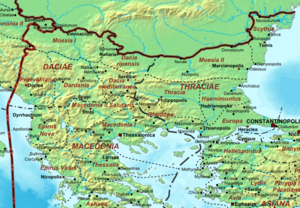
In 27 BC, Epirus became a Roman province. Later, around 103-114 AD, it became a separate province called Epirus. This new province included the northern Ionian Islands.
Around 284–305 AD, the western part of the province of Macedonia was separated and called New Epirus (Epirus Nova). Even though this area was not traditionally part of Epirus, it had become more Greek under Roman rule.
In the 4th century, Epirus was still a place where paganism was strong. After the Roman Empire split in 395 AD, Epirus became part of the Byzantine Empire. The Visigoths raided Greece, including Epirus, in 395–397 AD.
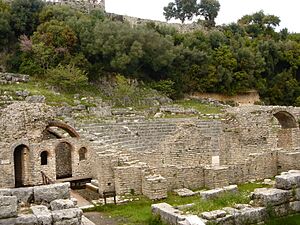
From 467 AD onwards, the coasts of Epirus and the Ionian Islands were attacked by the Vandals. They even captured Nicopolis in 474 AD. Emperor Justinian I (527–565 AD) rebuilt many fortresses in Epirus to protect against raids.
Epirus from Slavic Invasions to 1204
In the late 500s, much of Greece, including Epirus, came under the control of the Avars and their Slavic allies. Many bishops left their cities. Slavic tribes settled in the region, especially in the mountainous areas.
Over time, the Byzantine Empire slowly regained control. By the 9th century, Byzantine rule was largely restored in the mainland. This led to more Greeks moving into the area, and the remaining Slavs became Christian and adopted Greek culture.
During the 10th century, the region was raided by the Bulgarians. Under Tsar Samuel, most of Epirus came under Bulgarian rule. After the Byzantine Emperor Basil II conquered Bulgaria in 1018, Epirus returned to Byzantine control.
Epirus joined an uprising in 1040. It also suffered during the First Norman invasion of the Balkans. The Normans captured Dyrrhachium and Ioannina.
The Despotate of Epirus
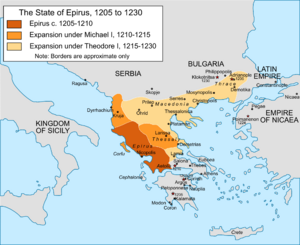
When Constantinople fell to the Fourth Crusade in 1204, Epirus was supposed to go to Venice. But a Greek nobleman, Michael Komnenos Doukas, took control. He established a strong state called the Despotate of Epirus, with Arta as its capital.
Epirus became a safe place for Greek refugees from the Latin Empire of Constantinople. The Despotate of Epirus ruled over Epirus and much of western Greece and Albania. Important cities like Gjirokastër were founded during this time. The first mention of Albanians in Epirus is from a Venetian document in 1210.
From the 14th Century to Ottoman Rule
In 1337, Epirus returned to Byzantine rule. But in 1348, the Serbian king Stefan Uroš IV Dušan conquered Epirus. He was helped by Albanian mercenaries. Later, Albanian clans invaded and took over most of the region.
Ioannina became a center of Greek resistance against the Albanian clans. The Greeks of Ioannina invited foreign rulers to help them. One of these was Thomas II Preljubović (1367–1384), whose rule was marked by constant fighting.
Another ruler, Esau de' Buondelmonti (1385–1411), also fought against Albanian noblemen. The Zenebishi clan controlled the area around Gjirokastër.
Carlo I Tocco (1411–1429) took control of Ioannina. He fought against the Albanian leaders of the Despotate of Arta. Carlo eventually ended the rule of the Albanian clans in southern Epirus.
However, internal disagreements made it easier for the Ottoman Empire to conquer the region. The Ottomans captured Ioannina in 1430 and Arta in 1449. By 1479, they had conquered almost all of Epirus.
Epirus Under Ottoman Rule
The Ottomans ruled Epirus for nearly 500 years. This period was difficult for the region. Many Epirotes left to escape poverty. However, some areas like Himara and Zagori managed to keep some independence.
Between the 16th and 19th centuries, Ioannina became a very prosperous city. It was a major center for the modern Greek Enlightenment, a period of intellectual and cultural revival. Many schools were founded there.
In the 18th century, as the Ottoman Empire weakened, Epirus became almost independent under Ali Pasha of Tepelena. He was an Albanian ruler who controlled all of Epirus and other parts of Greece. Ali Pasha used Greek as his official language. He also saw an increase in Greek cultural activities.
When the Greek War of Independence began, people from Epirus played a big role. Two of the founders of the Filiki Eteria, a secret society of Greek revolutionaries, were from Epirus. Ali Pasha was killed in 1822. When Greece became independent in 1830, Epirus remained under Ottoman rule.
There were several rebellions by local Greeks in 1854 and 1878, but they were put down by Ottoman forces. During this time, the Ecumenical Patriarchate of Constantinople tried to close Albanian schools. Publications in Albanian were also banned by the Ottoman Empire.
Epirus in the 20th Century
The Treaty of Berlin (1878) gave parts of Epirus to Greece. But due to opposition, only the region of Arta became part of Greece in 1881. After the First Balkan War (1912–1913), the rest of southern Epirus, including Ioannina, joined Greece.
Greece had also taken northern Epirus during the Balkan Wars. However, the Treaty of Bucharest (1913) gave Northern Epirus to Albania. This was not popular with the local Greeks, as many lived on the Albanian side of the border.
Local Greeks in northern Epirus revolted and declared their independence in February 1914. They formed the Autonomous Republic of Northern Epirus. After fighting, they gained self-rule under the Protocol of Corfu. This agreement recognized the rights of local Greeks. However, this republic was short-lived. When World War I started, Albania collapsed. Northern Epirus was controlled by Greece, Italy, and France at different times.
The Paris Peace Conference of 1919 awarded Northern Epirus to Greece. But due to Greece's defeat in the Greco-Turkish War (1919–1922) and Italian support for Albania, Greece did not keep Northern Epirus. In 1924, it was again given to Albania.
In 1939, Italy occupied Albania. In 1940, Italy invaded Greece. Greek forces pushed the Italians back into Albania and took control of northern Epirus again. This was an early victory for the Allies in World War II. Nazi Germany then intervened in April 1941. German forces made the Greek army in Epirus surrender.
All of Epirus was under Italian occupation until 1943. Then, the Germans took over. Due to strong Greek resistance, the Germans carried out large operations against partisans. They used Cham Albanians who collaborated with them, and these groups committed many terrible acts against civilians. The Greek fighters pushed them out of Greece into Albania. This led to the expulsion of almost all the Cham population to Albania.
After Greece was liberated in 1944, the highlands of Epirus became a major area for fighting in the Greek Civil War. The war ended in 1949. Because Albania supported the communists in the civil war, Greece and Albania remained in a formal state of war until 1987. During Communist rule in Albania, the Greek population in Northern Epirus faced pressure to adopt Albanian culture. Greek language education was limited or banned in public in many areas. Relations between Greece and Albania improved in the 1980s. Greece gave up any land claims over Northern Epirus, and the state of war ended.
How People Make a Living in Epirus
Epirus has rugged land, poor soil, and small farms. This means that farming does not produce much. The population density is low. Raising animals is the main industry, and corn is the chief crop. Oranges and olives grow in the western lowlands. Tobacco is grown around Ioannina.
Epirus has few natural resources and industries. Many people have left the region to find work elsewhere. The population is mostly centered around Ioannina, which has the most factories and businesses.
Getting Around Epirus: Transportation
Epirus has always been a remote area because of its mountains and sea. In ancient times, the Roman Via Egnatia road passed through New Epirus. This road connected Byzantium and Thessalonica to Dyrrachium on the Adriatic Sea.
Today, the modern Egnatia Odos highway connects Ioannina to Macedonia in Greece. It ends at Igoumenitsa. This highway has greatly reduced the region's isolation. The Ionia Odos highway connects Epirus with western Greece. The Aktio-Preveza Undersea Tunnel connects southern Epirus near Preveza with western Greece.
Ferry services from Igoumenitsa go to the Ionian islands and Italy. The only airport in Epirus is the Ioannina National Airport. The Aktion National Airport is just south of Preveza. There are no railroads in Epirus.
Images for kids
-
The old bridge of Konitsa over the Aoos river.
-
The Vjosa river near Tepelena.
-
Section of the Egnatia Odos, the only motorway in Epirus, near Igoumenitsa.
-
Preveza seen from the air.
See also
- List of cities in ancient Epirus
- List of Epirotes


